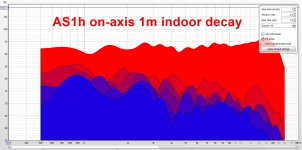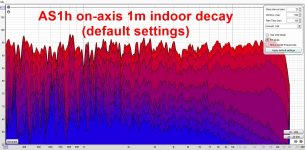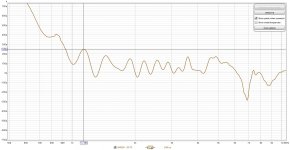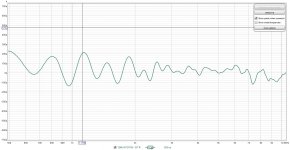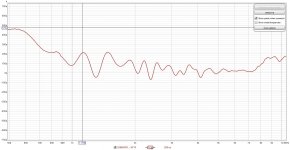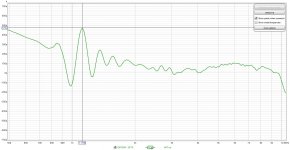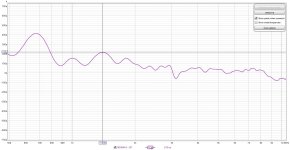https://hificompass.com/en/speakers/measurements/scan-speak/scanspeak-10f/4424g00The SS 10F is an interesting animal, but THD is way up there for a higher end mid driver.
Looks really quite good to me. The THD might not be the "best" but HD2 is the largest component of THD by far in practically all cases, and it's also the most benign form of non-linear distortion (in many cases inaudible up to 10% or more), so THD in itself is not a good measure for how audible the harmonic distortion is.
HD3 is also fairly benign, but likely not to the same degree that HD2.
The 10F SS is a good mid for sure and has a big following on here. It has a decent motor design and bandwidth for its size. The 2nd order HD on paper is pretty good down low comsidering its size and limited xmax, especially for lower output use. My issues with it are how it sounds when driven a bit harder. Crossed around 300-400 hz driven to mid 90s dB levels, it starts to get somewhat fuzzy, harsh and detached sounding in the upper mids. It may be the cone material and composition which gives it that character i don't prefer. To put it in simple terms, it tends to draw attention to itself under the above conditions and has that light paper cone sound. Even playing with various HP points and slopes doesn't seem to make a difference in this regard. However, of you keep the volume down in lower 90s dB it does well amd has that euphonic type of imagining associated with smaller mid drivers.
I will try an xo that is 20db-30db down at the FS as an extreme.
FYI/FWIW, -25 dB is considered to be the point where we can no longer hear something, though can perceive up to -40 dB under the right circumstances, so for the vast majority of situations a 4th order is good enough.
I cannot find a vm753 waterfall. The vm752 is what I thought looked slow.Volt Vm753 does have some energy storage
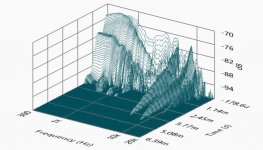
Much like the yamaha ja0801:


It would be nice to improve the 800hz on up a bit with no humps or shift in decay after just a few db drop.
Thanks, I am a newb and this helps.FYI/FWIW, -25 dB is considered to be the point where we can no longer hear something, though can perceive up to -40 dB under the right circumstances, so for the vast majority of situations a 4th order is good enough.
The hypex plate amps also recommend an LR4.
...
I refined the XO's a bit. Again, some of these might not be possible. Part of this for me is seeing where the tweeter and woofer fall apart.
I tried to throw a mix of solutions at it. One has a pretty good pref. score. (is pref. score all about flat power and directivity?). The one that is all 1st order XO's has the mid and tweeter playing at the same level. All of the XO's have a c-to-c of 350mm.
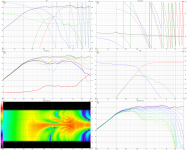
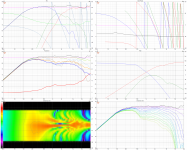
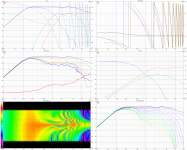
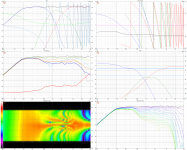
" I'd like to make something with a very fast decay from 500hz-5000hz. No bumps in the GD would also be nice."
To me first thought to achieve this is a 3-way with a wideband midrange and shallow LR xo or other types of xo giving minimal phase shift.
Now we have sims with a filler mid and two crossovers in 500-500Hz band... How come?
Duelund crossover starts as first order, gradually gets steeper creating elliptic acoustic curves, and introduces minimal excess GD.
"The transfer functions should be used as the acoustic targets for LP, BP and HP drivers and the filters developed to
achieve these results. In one considers the midrange driver we see further that given ω2, the midrange to
woofer crossover frequency, then what is really needed is a sealed midrange enclosure which yields a Qtc =
0.5 at ω2."
My approach here, crossovers basically LR2 but close to elliptic... Sounds nice

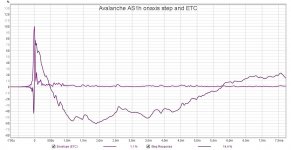
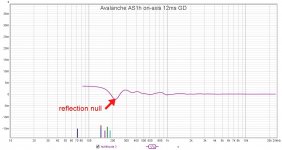
- fast decay - driver(s) playing in linear band, no cone resonances
- smooth GD - no xo or minimal phase shift
To me first thought to achieve this is a 3-way with a wideband midrange and shallow LR xo or other types of xo giving minimal phase shift.
Now we have sims with a filler mid and two crossovers in 500-500Hz band... How come?
Duelund crossover starts as first order, gradually gets steeper creating elliptic acoustic curves, and introduces minimal excess GD.
"The transfer functions should be used as the acoustic targets for LP, BP and HP drivers and the filters developed to
achieve these results. In one considers the midrange driver we see further that given ω2, the midrange to
woofer crossover frequency, then what is really needed is a sealed midrange enclosure which yields a Qtc =
0.5 at ω2."
My approach here, crossovers basically LR2 but close to elliptic... Sounds nice



Last edited:
It is very interesting to me that most people who experiment with a variety of drivers eventually discover that they all have a unique sound... a sound that transcends (or goes beyond) the system and crossover in which they are used. I have found this myself. We seem to be hearing differences that can't be easily explained by frequency response, dispersion, harmonic distortion, or other quantitative measurements. So what are we hearing? I do not know, and I do not have a good theory...The 10F SS is a good mid for sure and has a big following on here. It has a decent motor design and bandwidth for its size. The 2nd order HD on paper is pretty good down low comsidering its size and limited xmax, especially for lower output use. My issues with it are how it sounds when driven a bit harder. Crossed around 300-400 hz driven to mid 90s dB levels, it starts to get somewhat fuzzy, harsh and detached sounding in the upper mids.
I think that is why we like to look at CSD waterfall curves, TES waterfall curves, step responses, ect... assessing these curves is essentially a qualitative assessment, not quantitative. We can draw subjective conclusions from the curves and make connections to our subjective listening impressions. Perhaps the answer does lie within those plots. But it is also possible it lies elsewhere.
Profiguy, your impression of the SS 10F is very similar to the assessment of other well-made paper cone drivers. I have heard several experienced designers talk about the SS revelators and illuminators as becoming a bit "shouty" when driven hard. Similar comments about the Satori MW13P / MW16P / MW19P papyrus cone drivers.
j.
Hey! Thanks for posting the graphs and the XO. Looks cool! Do you use REW? If yes, can you post a decay graph like mine on page one of this thread?Now we have sims with a filler mid and two crossovers in 500-500Hz band... How come?
Back to your ?... How come? These were the first drivers I was interested in. The directivity kinda forced me into those XO's. I'll look at more mids. I think I am set on a t34b though.
..
Back to the idea of GD shift. This paper has a really small sample size but reveals some details:
https://ieeexplore.ieee.org/document/9450008perception is highly dependent on the signal, and the unit impulse and pink impulse are the most critical test signals. Negative group-delay variations are more easily audible than positive ones. The smallest mean threshold for the negative group delay was −0.56 ms and 0.64 ms for the positive group delay, obtained with a pink impulse.
Diff. sounds have diff. levels of sesitivity is my takeaway.
Hey! As usual from you, some very sound and sage advice.We can draw subjective conclusions from the curves and make connections to our subjective listening impressions. Perhaps the answer does lie within those plots. But it is also possible it lies elsewhere.
I agree that one should always keep an eye out for the unknowns or for getting lost in meaningless patterns.
The next step after drawing conclusions based on data is to test them. I've only done a few tests comparing the decay and sound samples across a few speakers. It was eye-opening how most of my speakers could not play a high-hat the same way. Making a speaker with a faster decay is inspired by what I heard and measured with these tests.
When looking at signs of a decent sounding, truly high end driver thst isn't fatiguing to listen to, it must be free of significant decay resonances ie. metal or other hard cone/dome materials exhibiting long breakup trails seen on CSD. Many of these drivers can't be tamed even if run well outside their breakup bandwidths with hgiher order filters. You can still hear the fatiguing sound signature on them when running them harder despite staying out of the -24 dB zone claimed to be the point you can no longer hear the resonance affects. Unlike a paper cone or soft dome driver that breaks up in a more aocoustically tolerable way, there will always be audible reminders of the diaphragm material you're listening to. I would claim the -40 dB point to be a safe operating mode for keeping the breakup from becoming recognized by the ear, especially if you notch out the resonance(s) and thats the only way I'd use a driver of this nature. I actually like metal alloy dome tweeters but I can only handle them at a higher output level if a notch is applied to the HF breakup point despite people claiming it to be well outside of human audible range. Even if you dont have a measurement mic that has the top end to pick up this area, you cam still look at the impedance curve for the tell tail spike despite how subtle it is and apply a 10 dB notch to it. Before you flame me claiming I am hearing ghosts, try it for yourself on any decent alloy dome and prepare to be surprised.
On the other side of cone materials, most paper cone mids become shouty at higher levels due to the imbalance caused by the driver compressing mainly around breakup while only the pistonic range increases in volume in proportion to the input. Most low Qms drivers exhibit this behavior and thats why they tend to soind warmer even when run in their breakup range. Most of the slit cone SS Revelators do this and its a sound signature that can't be filtered out unless you stay away from the breakup area (almost impossible).
IMO, the smaller Peerless NE series are the best paper cone drivers under $200 thanks to their stiff cone profiles, although that deep type of cone geometry causes off axis behavior issues, etc. Pick your poison. Also for me, one of the best small paper cone driver ever made was the M10MD-39 and its a huge shame it isn't available anymore. I just can't fall in love with any of the Seas magnesium alloy cone drivers, unless they're used as subwoofer drivers. If you look at the Harbeth LF drivers, they use a less dampened polymer cone that doesn't sound like a traditional lifeless and gutless poly cone. Thats probably why I like them so much, as you can hear lots of low level detail and don't hear any noticeable disconnect from the tweeter throughout the crossover region. I have some older 18W SS poly cones that have a 7.0 Qms and they definitely exhibit that magic Harbeth sound. Too bad SS doesn't offer a decent poly cone driver to the DIY crowd. The majority of poly cone drivers don't give detailed midrange and Vifa PH17WJ00 is one of them - its midrange just sounds boring to my ears. It may be smooth, but at the expense of almost zero macrodynamic detail.
On the other side of cone materials, most paper cone mids become shouty at higher levels due to the imbalance caused by the driver compressing mainly around breakup while only the pistonic range increases in volume in proportion to the input. Most low Qms drivers exhibit this behavior and thats why they tend to soind warmer even when run in their breakup range. Most of the slit cone SS Revelators do this and its a sound signature that can't be filtered out unless you stay away from the breakup area (almost impossible).
IMO, the smaller Peerless NE series are the best paper cone drivers under $200 thanks to their stiff cone profiles, although that deep type of cone geometry causes off axis behavior issues, etc. Pick your poison. Also for me, one of the best small paper cone driver ever made was the M10MD-39 and its a huge shame it isn't available anymore. I just can't fall in love with any of the Seas magnesium alloy cone drivers, unless they're used as subwoofer drivers. If you look at the Harbeth LF drivers, they use a less dampened polymer cone that doesn't sound like a traditional lifeless and gutless poly cone. Thats probably why I like them so much, as you can hear lots of low level detail and don't hear any noticeable disconnect from the tweeter throughout the crossover region. I have some older 18W SS poly cones that have a 7.0 Qms and they definitely exhibit that magic Harbeth sound. Too bad SS doesn't offer a decent poly cone driver to the DIY crowd. The majority of poly cone drivers don't give detailed midrange and Vifa PH17WJ00 is one of them - its midrange just sounds boring to my ears. It may be smooth, but at the expense of almost zero macrodynamic detail.
Decay - Indoor measurement at 1m of my 3-way in post #25 (noice high spl!)
- decay of indoor measurement is not very valid, lots of problems
- decay shows mostly interference problems and driver resonances
- EGD is one way to show effect of a multiway speaker's xo, others are step response and ETC.
Attachments
Last edited:
@Juhazi Thanks for posting that. Your decay is so even all the way across! My 3 way is like -3db down after 2ms whiles yours is -7db in places.
@profiguy Cool info! I'll try a notch.
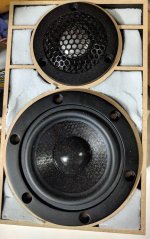
I hope to make a similar baffle for this project if I can prove it works for my 1st one. I'll know soon enough.
So this could be one way to deal with resonances but I do not know for sure. If it works out, I would make the chamber deeper for this new project. This should increase the range of frequencies that I am zapping.
@profiguy Cool info! I'll try a notch.
I might have a way to help zap some of those issues. This is what is behind the felt and perforated metal sheet for my 1st speaker posted on page 1. I've only made 2 test baffles so far. The early measurements do show a -6db reduction in the decay. The tricky part is getting the center frequency right. In the pic are the air chambers that are 5mm melamine + 5mm air space.When looking at signs of a decent sounding, truly high end driver thst isn't fatiguing to listen to, it must be free of significant decay resonances ie. metal or other hard cone/dome materials exhibiting long breakup trails seen on CSD.

I hope to make a similar baffle for this project if I can prove it works for my 1st one. I'll know soon enough.
So this could be one way to deal with resonances but I do not know for sure. If it works out, I would make the chamber deeper for this new project. This should increase the range of frequencies that I am zapping.
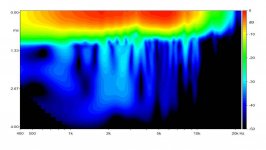
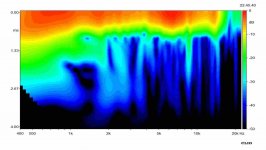
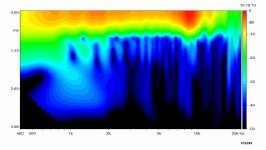
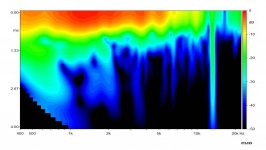
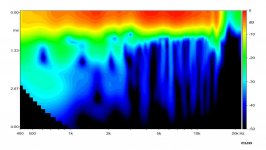
Found some data on lots of dome mids. Seems the dynaudio m560da is the cleanest. The visaton dsm50 seems like a nice second choice that I can actually buy.
http://www.dibirama.altervista.org/le-prove/mid-range.html
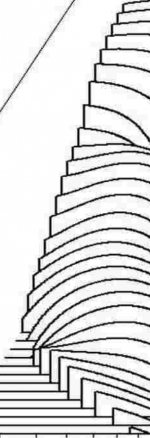
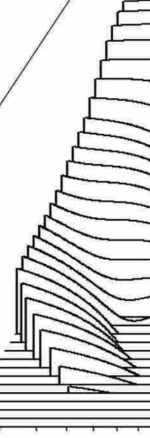
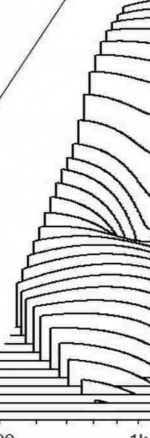
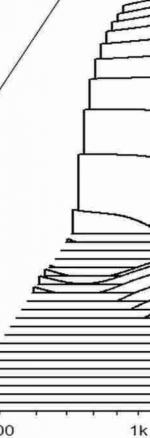
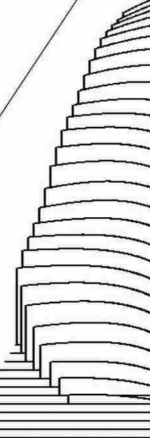
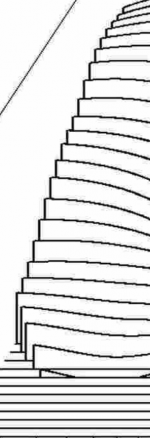
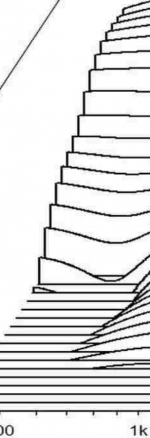
This is more data from http://www.dibirama.altervista.org/le-prove/mid-range.html .
I'm a fan of flipping through images quickly for comparisons. Since the SPL of the operating range does not line up in a normal waterfall I put the top right corner on the SPL line of each driver around 1200hz. The drivers are clipped at 400hz and 500hz is in the bottom left corner.
The visaton is $100USD each and the dynaudio is $600USD each. Quite the jump.
The XOs for each will be a bit different but I think I want something that is flat most of the way down.
I'm wondering if There was not early batch problems with the satori MD60N-6 because I have not the same appreciation of it concerning the sound and the distortion.

Last edited:
Thanks for posting that, @atoluma ! Can you generate a "decay" graph like the one on page one. If yes, be sure the match the settings and uncheck all but 1-4ms.
The datasheets on 1/2 the websites don't match the final datasheet on sba's site. There was a change between what won the audio show 3way category and what we can buy. Who knows what they sold along the way? I agree that the distortion does not look bad. Your distortion is just as low as hificompass or dibirama.
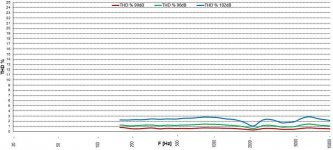
I don't doubt @profiguy 's review though- it makes me wonder what is tied to his preference. @profiguy do you listen crazy loud to music? I had hifijim over the other day and he reminded me that I listen pretty low. Maybe crazy low.
...
side note: I forgot to mention it, on the little B/W waterfall boxes in post no. 32, each slice is 0.11ms.
The datasheets on 1/2 the websites don't match the final datasheet on sba's site. There was a change between what won the audio show 3way category and what we can buy. Who knows what they sold along the way? I agree that the distortion does not look bad. Your distortion is just as low as hificompass or dibirama.

I don't doubt @profiguy 's review though- it makes me wonder what is tied to his preference. @profiguy do you listen crazy loud to music? I had hifijim over the other day and he reminded me that I listen pretty low. Maybe crazy low.
...
side note: I forgot to mention it, on the little B/W waterfall boxes in post no. 32, each slice is 0.11ms.
I think I listen at slightly above average levels when I am doing critical listening. So the difference between you and me is probably 10 dB... Your Bliesma T25B + Eton 3-212 system is really sounding good... very dialed in. Tonal balance is spot-on, and a great sense of space and depth.
You should try and find data on the Morel 50 mm domes. At one time in the distant past, Morel and Dynaudio were quite similar. There was some sort of co-production agreement between them. Unlike Dynaudio, Morel drivers are available at reasonable prices.
You should try and find data on the Morel 50 mm domes. At one time in the distant past, Morel and Dynaudio were quite similar. There was some sort of co-production agreement between them. Unlike Dynaudio, Morel drivers are available at reasonable prices.
Good tip. I think the BlieSMa guy worked for Morel too.You should try and find data on the Morel 50 mm domes.
Yeah, it is pretty expensive for what it does. But when you consider where and how it is made then that explains why- well to me anyway.Unlike Dynaudio, Morel drivers are available at reasonable prices.
Also, thanks for the kind words about my taped-up boxes! They would not exist w/o your help!
....
Another look at some drivers with a GD graph. This time I imported the impulse from http://www.dibirama.altervista.org/ into REW.
There is a morel driver in the mix.
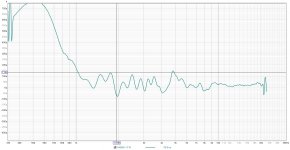
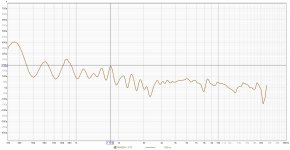
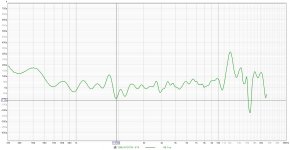
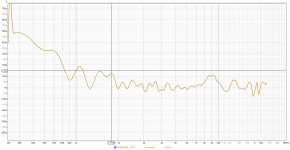
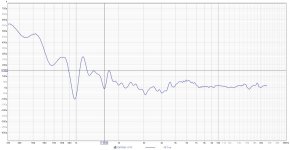
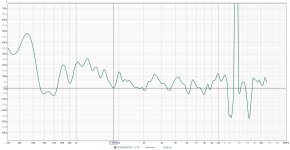
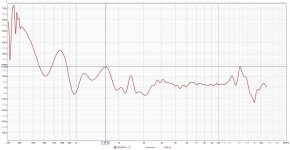
...
Last edited:
What SPL and distance is that measured at?I'm wondering if There was not early batch problems with the satori MD60N-6 because I have not the same appreciation of it concerning the sound and the distortion.
View attachment 1024330
I listen on the loud side, sometimes too loud... but not for long periods of time. Maybe 15 min at a time with peak levels around 105 dB or so, depending on how comoressed the audio is mastered.
The main issue with the MD60-N is the distortion around 800 - 1200 Hz. It has this honk that can't be removed with EQ and it draws attention to itself at over 90dB. I don't think its a production issue and the units I tested were purchased around middle of 2021. I think its the neo motor design and the presence of a secondary cavity resonance, sort of like many chambered Hf domes have. It can be seen on the impedance plot and looks like there are two primary impedance peaks sort of melted into one. This is a result of insufficient venting between the two air cavities that make them exhibit a separate coupled resonance that causes a spike in THD.
The issues in the MD60-N may be greatly suppressed by a revised rear chamber design. It may be possible to remove the original rear chamber on this mid and use a larger and longer one. I wasn't brave enough to disassemble mine because I wouldn't have been able to return them.
The Visaton DSM50 is a nice mid dome and has a very detailed neutral sound. It shouldn't be used under 1 k with an electrical LR2 HP. Its the best metal dome mid available to this date (with possible exception to the Bliesma mid domes). I have some D52AF dynaudios that i like very much. They have that dynamic and fast sound that most large mid domes don't possess and they can play blistering loud without changing their character. The Morel dome mids are really nice too and may be an option for you as well, especially at the levels you listen. I've used all versions of their 2" soft dome and they all sound very nice with my favorite being the EM1308. The only issue it has is the large faceplate which doesn't allow for close tweeter placement without a bit of baffle modification.
I'm very sensitive to midrange distortion and response anomalies, more so than the average hifi person. The band between 700 and 5 k has to be under 0.5% THD at mid 90s dB to be considered true high end midrange reproduction and have no sudden phase shifts or decay artifacts past 3 ms at -24 dB. Thats a hard standard to achieve but its the level of fidelity you need in order to not become listening fatigued. Most compression driver setups are hard for me to listen to because of this pickiness I have, even if the HD is made up of mostly 2nd order components. The 3rd and 5th harmonics are what really kill it though.
- Home
- Loudspeakers
- Multi-Way
- Headshake's far field 3way
